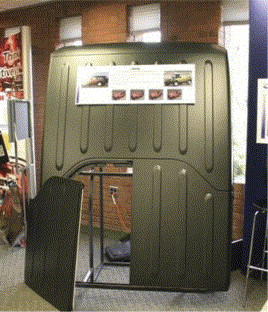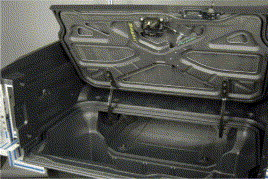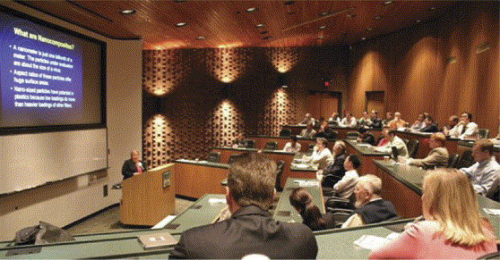


On what was arguably the three wettest days of the year, over 400 people converged at the Michi-gan State University Manage-ment Education Center in Troy, a northern suburb of Detroit, Michigan, USA, to attend the 6th Annual Society of Plastics Engineers Automotive Composites Conference and Exhibition on 12-14 September 2006. They came from around the globe to participate in over 60 presentations, peruse five rooms of displays by various suppliers, listen to three discussions by panelists consisting of original equipment manufacturers (OEMs) and suppliers, hear eight keynote speakers tell of the past, present and future of composites and their applications – and, of course, renew friendships and network.
This year's theme – Composites: Efficiency, Value, and Performance – seemed very appropriate. Discussion was varied and thrilling. Comparisons consisted of composite airplanes built not to crash at one end of the spectrum, to racecars built to withstand a crash, at the opposite end. There was an air of optimism in the conference. The weight advantage of plastics was expected to come to the forefront with the general increase in the price of oil and the growing awareness of carbon dioxide (CO2)-fed global warming and exceptional and successful use of plastics in the aerospace industry.
The conference continued with a long and impressive list of presentations outlining the many innovations and improvements in composite technology, both novel and evolutionary. Many success stories were relayed. But at the same time the optimism was tempered by panel members, questions and comments from the participants, and keynote speakers who pointed out that the challenges, if possible, have become even more daunting.
Optimistic
The most optimistic remarks came from the first and last keynote speakers, Dr Michael Fisher of the American Plastics Council (APC) and James Griffing of Boeing Commercial Airplanes.
Dr Michael Fisher, APC, began by saying there are times when the world needs big ideas. The time is now for composites. He quoted Francois Castaing, former vice president of engineering of Chrysler Corp a decade ago saying: ‘Steel is for cars; aluminium is for airplanes; and plastics are for toys.’ Fisher felt this has changed for planes and was on its way to changing for cars.
The newest Boeing is 50% plastic as is the McLaren Mercedes SLR, as presented in the conference. Fisher used maxims of Toyota as a model:
- 1) embrace change that you cannot control; and
- 2) have a vision, because if you know where you are going, you will have no problems, just challenges.
Fisher called upon the plastics industry to pre-competitively speak with one voice and, with regard to the plastics vision which he called a roadmap, called for an updating of the Plastics in Automotive Markets Vision, the present version of which is now five years old. He said we need to be open to outsourcing some of the American manufacturing because globalisation is a requirement in these economic times, but we need to retain leadership, in both technical expertise and innovation, to achieve success. These should be key portions of the updated roadmap as they are in the present one.
Fisher ended by predicting that the use of 10% plastics in today's automotive would increase to 50% in tomorrow's. Asking for input he directed participants to write to www.plastics-car.com.
James Griffing, Boeing Commercial Airplanes, provided another optimistic note when he outlined the 787 Dreamliner design and construction. The Dreamliner isn't automotive but it is a great composites story and may be the forecast for the future of automotive. Boeing's use of composites has increased through the years from the 747 at 1%, to the 777 at 11%, to the computer-designed 787 at 50%. Of particular note was that all properties, including strength, life predictions, and fatigue, were computer simulated with excellent agreement with actual test results. Half the 787, including the majority of its structural parts, is comprised of plastic composites. This plane is now certified by all governmental agencies and is set to begin production shortly. The initial build time is expected to be one month, decreasing to a goal of three days.
Novel and evolutionary
The conference was filled with papers, panels and keynote speakers outlining new or improved ideas for plastic composites. Many papers dealt with more ways to use glass fibres, especially long glass fibres, which were shown to simultaneously increase strength and impact resistance. Data was presented to verify that uniform distribution across the entire part could be achieved, including in such difficult applications as narrow and projecting areas. The addition of long glass fibres allowed for thinner walled, stronger products, and thus better overall material reliability. Other papers covered resin choices, additives, and natural fibres.
The use of long glass fibres (LGF) per a paper published by Jeroen Van Poucke, Dow Automotive, showed how long glass fibres in polypropylene (PP) can improve both strength and impact resistance. Dow offers concentrates: pellets that are fully formulated and ready to be mixed, with up to 40% filler at the moulders.
Tim VanAst, Ticona Engineering Polymers, outlined the use of long fibre reinforced thermoplastics. He indicated the first choice was most often long glass fibres (LGF) in PP because of its excellent properties, but went on to describe a wide range of plastics and fibres for different applications. He showed skeletal pictures of a finished composite gear with the plastic matrix removed in-situ and the LGF were evenly distributed, even in the hard-to-reach places like the gear teeth and thin walls.
Steve Hardebeck, Reichhold, suggested mixing vinyl ester resin and polyester for good properties at lower cost.
Hamid Kia, General Motors (GM), reported on work done to develop the powder coating of sheet moulding compound (SMC) body panels. He outlined that air (mostly) and water inclusions in powder coatings must be controlled to avoid bubbles and leather-like appearance in SMC Class A finished panels. Changing the polyvinyl acetate low profile additive, care in storing and transporting the body panels between forming and powder coating, among other changes, make powder coating SMC panels workable for a Class A finish.
The conference attendees learned later the importance of proper coating of body panels to the automotive sector when the Ford keynote presentation and several panel discussions indicated that both GM and DaimlerChrysler are concerned about the quality of powder coatings for SMC body panels.
Other methods of adding value to composites were addressed by many presentations on additives. These fell into categories. Nanoclays (10−9 m versus 10−6 m for normal additives) promise better stiffness and scratch resistance. In addition nanoclays are used to reduce permeability in gasoline tanks and fuel lines. Nanocarbon fibres exhibit improved stiffness, strength, conductivity, and wear resistance. Graphite particles are being developed to give most of the benefits of nanocarbon fibres at a considerably reduced cost. Reduced-size glass bubbles produced by 3M increased stiffness and reduced weight. It was pointed out by most authors that all of the nanoparticle additives must be handled carefully to avoid aggregation and that, in most cases, they adversely affect impact resistance and this issue must be addressed.
Several papers, panel members and Rogelio Sullivan, United States Department of Energy (contract with Argonne National Laboratory), addressed the need for and future availability of low priced carbon fibres. Most comments reflected a feeling that carbon fibre growth in automotive will be slow at this time until there are more breakthroughs.
One possible present application for nanocarbon was mentioned by Andrew Rich, Nanocyl, who suggested that use of 0.5% of both nanoclay and nanocarbon fibre would result in a flame retardant product by stabilising the ash.
Many papers addressed natural resins and fibres. Natural resins suggested: polyactide (PLA) from corn; poly (lactic acid) from fermentation of corn or potatoes; and soy-based resins. Natural fibres included: flax; hemp; jute; henequen (fibre of the Agave); wood; coir (coconut husk fibre); kenaf (East Indian fibrous plant); grass; pineapple leaf fibre; and others. All promise renewable raw materials that are more environmentally friendly. The natural fibres are reputed to be one-quarter the cost and half the weight of glass fibre. Glass fibres represent 95% of the fibres used in composites. Natural fibres, however, have lower strength, lower stiffness, and less consistent properties than glass fibres.
Process improvements and testing
Several papers outlined better means of controlling the design and manufacture of composites. Jacqueline Ayotte, Ticona Engineering Polymers, described a new computer-controlled method to determine the distribution of the lengths of glass fibres. The method takes 25% of the time and eliminates much of the operator error that was present in the old microscopic method. The suggestion was made that it might become a commercially available process in the future.
Dr Michael Siwajek, Continental Structural Plastics, outlined a methodology to identify all the important variables and a test procedure to find the most important factors and to optimise them.
Francis Krantz, Ashland, introduced a method to analyse flow properties and cure times in a fibre reinforced thermoplastic system. A laboratory mould with dielectric heating and a full array of sensors is used. The mould is heated, the resin crosslinks, and the impedance of the resin decreases. By measuring temperature and impedance as well as the cured product, a histogram outlining temperature, time of gel, flow, and subsequent cure can be developed. This allows production samples to be accurately tested for small variations in production lots and it can also be used to develop new products.
Paul Schuch from Robotic Production Technology introduced an all-robotic SMC production method, thus avoiding quality problems introduced when the operators were required to physically touch the parts.
Eric Lee, of PlastComp, detailed the advantages of direct in-line compounding including smaller investment and lower cost per pound. Manfred Brummer, from Dieffenbacher, also suggested direct in-line compounding and described a new low stroke, low energy moulding press to further reduce costs.
Paul Stassen from AddComp reminded the conference attendees that plastics do degrade with time and exposure to light. Inert polymers are technically impossible due to impurities, catalytic residues, structural defects etc. Auto-oxidation (rate of radicalisation) cannot be avoided and is self accelerating unless it is controlled by radical scavengers or radical quenchers and ultraviolet (UV) absorbers.
SMC was covered extensively during the conference and included information on new additives, laser surface analysis, viscosity test methods, moulding and handling innovations, powder coating painting, and new applications. These subjects are included elsewhere in this article.
Success stories
It was also clear that composite technologies have examples of great successes: Honda's Ridgeline Truck bed, displayed in the lobby by Meridian – SPE Automotive Division's 2005 Innovation Award competition's ‘Grand Award’ winner, the McLaren Mercedes SLR carbon fibre body, Ford GT carbon fibre inner deck hood, long glass fibre PP instrument panel with steel bar reinforcement designed by Delphi, the Boeing 787 which is 50% composite, and even the Ford SMC body panels with 2.5 million parts built in 2002 which is both a failure and a success story.
Nobuya Kawamura, Toyota Motor Corp, pointed out that automotive plastics' use increased from 3% in the 1960s to 9% at present. He outlined the global warming case and its effect on CO2 emissions by vehicles and illustrated a few excellent lightweight products made with plastics, like fuel tanks, intake manifolds, and drive shafts. Kawamura also noted that, since the advent of carbon fibre composites use in racecars, the number of deaths has decreased greatly. However, he considered the inability to recycle composites a downside to more automotive plastics applications in Japan.
The story at Ford, presented by Dr Jeff Helms, showed both failure and success. While SMC panels grew from 250 000 in the 1990s to 2.5 million in 2002, multiple problems arose. Ford was quantifying 230 defects/1000 vehicles. A cross-company task force was formed, comprised of Ford and its suppliers, and identified the problems which were microcracks, cracks after prime, and edge porosity. They developed an advanced SMC with conductive sealer and conventional primer and drove the warranty down to 3-4 defects/1000 vehicles. The quality was equal to or better than metal, the cost was in line, and the parts were lighter. However, the damage was already done. Many programmes were cancelled or returned to metal. In-house engineers had become disillusioned by SMC and decision makers were wary.
Challenges
The increased use and trust of composite materials is not without its challenges.
Comments
One young engineer in the audience said that he learned engineering at the university, graduated and then learned materials use from the older engineers for whom he worked. If they didn't know about composites or had had a bad experience with them, then they steered toward other materials and he was not able to learn about plastics from them. He suggested learning sessions where young people or those not familiar with composites could get more of a feel for the materials and their properties.
Another query was, ‘Where is the clearing house for information sources, eg. which university is doing what and where one can go for more advanced courses in the composites area?’ One suggestion was the Automotive Learning Center's website: plastics-car.com. This same website speaks to the recyclability of the car, about which the OEMs were questioned. Only one, Toyota, said it was an important consideration.
The increased price of gasoline obviously makes weight savings more important which is a plus for composites. The timing seems right to make the case for lightweight plastics and the OEMs said they wanted better fuel economy. However, several presenters pointed out that the government divides the vehicles into weight classes which determine how the fuel economy tests are run. If a vehicle is close to a weight class cut-off point, then saving weight is significant. If, however, the vehicle is in the middle of a weight class, weight savings are unimportant. But weight is always of significance for the airplane and heavy-duty long distance vehicles. That was proven by the amount of composite material Boeing designed into its newest product.
Key predictive engineering of composites should involve the Department of Energy's National Laboratories and universities for computer modelling. The National Science Foundation should be involved as well. Integrate basic and applied research work in parallel for polymer composites.
There is a need for improved science and engineering teaching in schools and educational infrastructures.
First: The number one observation of all of the OEMs was the importance of price, whether it was during a panel discussion such as Ford, GM and DaimlerChrysler saying a business case must be made for the use of composites, or during the first panel discussion where all the OEMs just said price, price, price. Dr David Cole, Center of Automotive Research, pointed out that the real price of cars has been decreasing for 10 years. Cost pressures are everywhere and the plastics industry must be part of the solution if use of composites is to grow.
Second: Better education of, and tools, for decision makers and design engineers must be provided. ‘Give us the information and the tools’ was a common request by the OEMs. Most panelists felt the predictive (CAE) models and especially crash models were needed. OEMs said to show them the data that proves that the models used for predicting composite properties in use are accurate and robust. OEMs requested the suppliers work with them and provide them with data and computer simulations. The panelists suggested that the people within companies meet and discuss the best materials for each application.
“Aluminium guys, steel guys, composite guys don't meet enough,” said Cole.
“Composite CAE tools need to be improved,” Jeff Helms, Ford, said, referring to the virtual tools used to predict the properties of materials.
Hannes Fuchs, Multimatic Engineering Services Group, told of the OEM supply team which chose aluminium crash structure over plastic partially because aluminium had better design tools, eg. ‘ability to analytically predict crash performance.’
However, within the composites community there seems to be more trust of the predictive tools. Olivier Guillermin, of Vistagy, indicated that Formula One racing cars use composites extensively and, because of the short time frame between concept and production, that use would be impossible without accurate predictive models. In addition, James Griffing of Boeing repeatedly mentioned that predictive values closely matched test values. He stated that the airplane wings were subjected to 3x life testing and then further tested to failure, passing with a small amount of margin due to excellent predictive tools. These concurred with statements made by representatives from Meridian Automotive Systems and Continental Structural Plastics. The comments made it clear that many in the automotive industry do not know of, or do not trust the predictive models that are available. It appears that more development of models and proving the validity of the models are needed and definitely more explanations and education are needed as well.
Third: Continuous improvement in the products and processes are needed just to stay even. Steel and aluminium products are continuously being improved and metal manufacturers seem to be well organised and can move fast to adjust to changes to supply the auto industry with the products it needs. The United States Council for Automotive Research (USCAR) in 2000 said the plastics industry was too shortsighted and competitive. The plastics industry needs to match the metal industry's unity of purpose.
Long term goals
The air at the conference was one of guarded optimism. Suppliers knew they had to work hard to sell their good products and were asking customers what it would take to get their products in the door. They were getting some answers: accurate predictive models and low cost. Meanwhile, composites people need to speak with one voice, focus on common objectives, and develop long term goals.





